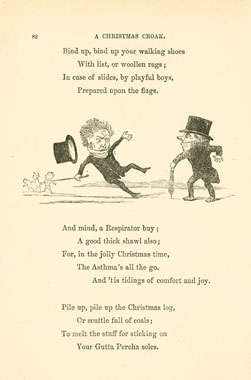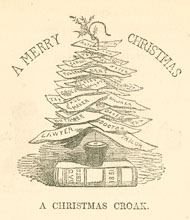December 8, 2011, by Fraser
8 December: A Christmas Croak
 This is the opening to ‘A Christmas Croak’ which was first published in 1861 and is an alternative version of Christmas favourite God Rest Ye Merry Gentlemen.
This is the opening to ‘A Christmas Croak’ which was first published in 1861 and is an alternative version of Christmas favourite God Rest Ye Merry Gentlemen.
Robert Brough’s miscellany A cracker bon-bon for Christmas parties: consisting of Christmas pieces for private representation and other seasonable matter, in prose and verse, in which the song appears, is housed in the University’s Briggs Collection of Educational Literature.
The illustration to accompany the opening verses of the piece is of a Christmas tree made up of bills for expenses such as ‘shoemaker,’ ‘tax’ and ‘rent’ which sits upon a book entitled Bad Debts 1851. If you would like to read A Christmas Croak in its entirety, you can view it as a PDF.
The collection was compiled with the intent of entertaining the family over Christmas – something that we still endeavour to do today with charades and party games, as well as DVDs and games consoles. We asked Dr Richard Gaunt from the Department of History about where some of our current traditions come from and about what constituted a Victorian Christmas.
The changing face of Christmas…
‘The Victorian Christmas was organised around the home and the family. Because of this, many of the pastimes and activities which we today associate with the ‘traditional Christmas’ were innovations of the Victorians. Some of them – such as the introduction of the Christmas tree and the fashion for German confectionery – were due to the influence of the Prince Consort, Albert, who married Queen Victoria in 1840. Pictures of the royal family crowded around a Christmas tree set a new fashion for domestic festive adornment.
Christmas remained first and foremost a religious festival for the Victorians. Christmas Day was also a time for friends and families to gather together around the hearth, exchanging stories and presents, singing carols and enjoying their Christmas feast. Turkey was gaining popularity as the standard fare but roast goose, lobster salad and oyster rolls were considered delicacies of the Victorian Christmas table. Home entertainment in an age before the mass media relied on family involvement with music, singing, dancing and parlour games like charades.
Charity was equally important as celebration and a natural extension of the festival’s religious significance. ‘Almsgiving’ and Christmas ‘boxes’ were traditionally distributed on the Feast of St Stephen or ‘Boxing Day’ (26 December) in emulation of ‘Good King Wenceslas’ (who was celebrated in carol). Likewise, St Thomas’ Day, which coincided with the Winter Solstice (21 December), saw the poor ‘go a-gooding’ by visiting more affluent neighbours in the hope of gaining money or provisions for Christmas. The sentiments behind this process survive in the Christmas rhyme ‘Christmas is coming, the goose is getting fat, please put a penny in the old man’s hat, if you haven’t got a penny, a ha’penny will do, if you haven’t got a ha’penny, “God Bless You!”’.
This stress upon the reciprocal relations between rich and poor was reflected in the stories of Charles Dickens and in Christmas presents; these were often homemade rather than expensive shop-bought items, although richer households were increasingly well catered for by shops and emporia. However, the idea of hanging up a Christmas stocking – which has today become a ritual for children on Christmas Eve – only began to take hold from about 1870.’
Dr Gaunt is Associate Professor in British History in the Department of History. Recent collaborations with Manuscripts and Special Collections include work regarding WE Gladstone, Politics of the 4th Duke of Newcastle and Dr Gaunt is currently working with the section on the military and political career of Lord William Bentinck.
All of the items featured in our e-Advent calendar are from the University’s historic library holdings, held in Manuscripts and Special Collections. For more information on the wide range of materials available, take a look at their website and blog or contact the curators on mss-library@nottingham.ac.uk
![]()
Find out more about our Manuscripts development plans and how you can support us via the Impact Campaign website.
No comments yet, fill out a comment to be the first


Leave a Reply